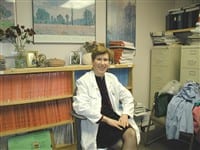Serving The Uninsured The Region’s Hospitals And Community Health Centers Both Bear The Strain
To Dr. Jeffrey Scavron, a physician’s obligation is clear.
“Our job is to take care of people in need,” he said — no matter how well they are insured.
Scavron, medical director of Bright-wood Health Center/Centro de Salud in Springfield, recalled one patient in particular, a man whose wife was in for treatment while he sat in the waiting room. After being told by the woman that her husband needed medical attention, Scavron went out to talk to him. As it turns out, the man had no health insurance.
“I said, ‘come on, let’s make an appointment. I don’t care if you don’t have insurance. We can cover that,’” Scavron said. “The guy started crying.
He didn’t realize he could take advantage of that.”
In any good-sized city, the percentage of residents who live at or near the poverty line — and even many of those who don’t — struggle for access to health care because of a lack of insurance, many of them clogging hospital emergency rooms with routine ailments. But, between the state’s free care provisions and other local resources, residents don’t necessarily have to grow sicker or use the ER, Scavron said.
“You are obliged to look at the community you serve and set up a system for that community to care for people,” he said. “We have multiple ways in this state to take care of those things, and certainly, community health centers are able to do that.”
The problem is, thanks to recent Medicaid cuts in the state budget, the number of uninsured could grow significantly in the coming year, further straining the ability of providers to give proper care. But that’s life in a city, providers told The Healthcare News — and it’s a problem that won’t go away anytime soon.
Stress and Strain
Of the 455,000 residents in Hampden County, according to the 2000 U.S. census, 16.6{06cf2b9696b159f874511d23dbc893eb1ac83014175ed30550cfff22781411e5} of all residents — and 26.9{06cf2b9696b159f874511d23dbc893eb1ac83014175ed30550cfff22781411e5} of children — live below the established poverty line, figures that are much worse than the statewide poverty numbers. And even many of those above that income level feel the effects of a protracted economic downturn and job losses. That means, in many cases, reduced access to health insurance.
Medicaid isn’t always the answer, as evidenced by a decision by state lawmakers to cut out a $70 million slice of the Medicaid pie that could cause up to 50,000 long-term unemployed residents to lose their coverage, even as the entire state program did receive a budget increase of $250 million for 2002-03.
How many of that 50,000 live in Springfield or its environs is impossible to say. But, already, hospitals must deal with the ever-present problem of uninsured residents using the emergency room — from which they cannot be turned away — for primary care, having nowhere else to go.
“Our emergency rooms often function as primary treatment facilities for these patients and their families while, at the same time, attempting to provide true emergency care for life-threatening illnesses,” said Dr. Douglas McKell, senior vice president of Mercy Medical Center. “We certainly see a lot of this at all urban hospitals. It’s common, and it’s likely to increase in Massachusetts.”
One reason for that potential increase, he said, is that access to both primary care and specialty care physicians seems to be decreasing. Doctors constrained by rising malpractice insurance costs, escalating litigation threats, and limits on state reimbursement have begun to display an alarming rate of physician flight from Massachusetts.
“It’s a very attractive area, but we have a number of built-in limitations that other states don’t have, at least not to the same degree,” McKell said. “We do a tremendous amount of training of physicians in this state, but we have to improve our ability to retain them. We’re also beginning to experience an earlier-than-expected retirement of some physicians. There is a limit to the numbers of patients that can be seen.”
The state’s uncompensated care pool to treat the uninsured remains a crucial link to treatment, he said, but with access to PCPs dwindling even for the insured, hospital ERs bear an increasing burden to provide primary care.
That presents several problems, he said. For patients, it means waiting longer to take care of routine conditions that would have been easily remedied through primary care with fewer complications. For hospitals, it means an added burden on the triage system that prioritizes the needs of ER patients — and it also requires hospitals to use more costly treatments and equipment to accomplish the same result a PCP could for much lesser expense. And those factors don’t even take into account the potential for patient diversions from overcrowded ERs.
“We will devote extensive resources to treating a less complicated condition that could be treated in a less complicated way at a different site,” McKell said. “That’s the structure and setup of an ER, and there is a cost to it. When the state looks at the cost of it and decides to reduce the reimbursement, we are required to continue the service. We don’t have the choice of turning someone away.”
Meeting the Need
To Scavron, it shouldn’t come down, at least not as often as it does, to frantic triage of non-emergency patients at hospitals.
“We tend to look at these things in segments: how it will affect the hospital, the emergency room, the patients,” he said. “But community health centers in Massachusetts are the number-one treater of all these folks who don’t use the ER as their only care.”
The truth, Scavron continued, is that health centers such as Brightwood must take on the cost of caring for everyone, whether through the state’s free care system or by some other means.
“In the north end of Springfield, we have a lot of groups getting together and trying to set up a system where everyone in this community can come into care and get the health care services they need,” he said. “If they’re uninsured, there’s still a free care pool. Hospitals still get paid.”
In fact, Scavron added, despite the talk of inadequate Medicaid reimbursement for medical providers — a figure that averages about 70 cents on the dollar, by most accounts — the real issue is the rising cost of health care in general. In fact, he noted, most states don’t have a free care pool for the uninsured at all.
Despite the hurdles, and especially in an urban area, “our job is to take care of people who have the most need, to give them as much up-front primary care as we can — not just doctors, but education, case management, coordination of care, and reducing barriers to care. In the long run, it reduces the cost of care, and that’s the way to do it.”
The uncompensated care pool, Scavron noted, is a statement by the state that people will not be allowed to go without any type of health care. The challenge is to make sure everyone gets into the system — and ensure that the system can handle the burden.
The Bottom Line
When discussing the uninsured population, providers keep coming back to the idea that everyone should have access to care, regardless of their financial situation. But emergency rooms aren’t the ideal place to meet those needs, McKell said, if only because by the time a patient makes the decision to go, a minor condition might already be exacerbated to something more serious.
The debate is ongoing whether the state’s free care provisions do enough for patients at the community health center level — and also whether there is enough access to physicians outside the hospital setting. And it’s a debate that should continue during a year when not just health care but all aspects of public life are being hit hard by budget cuts.
“Providing health care to these individuals who need it is a challenge for all of us,” McKell said. “We’re caught up in a vicious cycle, and there are no easy answers.”
Yes, the doctor will see you now. But somebody has to pay the price.




Comments are closed.